Wandering Cowrie
 |
 |
| Erronea errones with its mantle extended, covering the shell (left) and with the mantle retracted exposing the glossy shell (right). (Photo credit: Ria Tan)[1] |
|
[1] What is this....
Table of Contents
[2] I have never seen a cowrie before!
This is quite an impossible statement especially if one resides in Singapore. Other than being the most common cowrie seen on the shores of Singapore, you would have probably seen it here as well...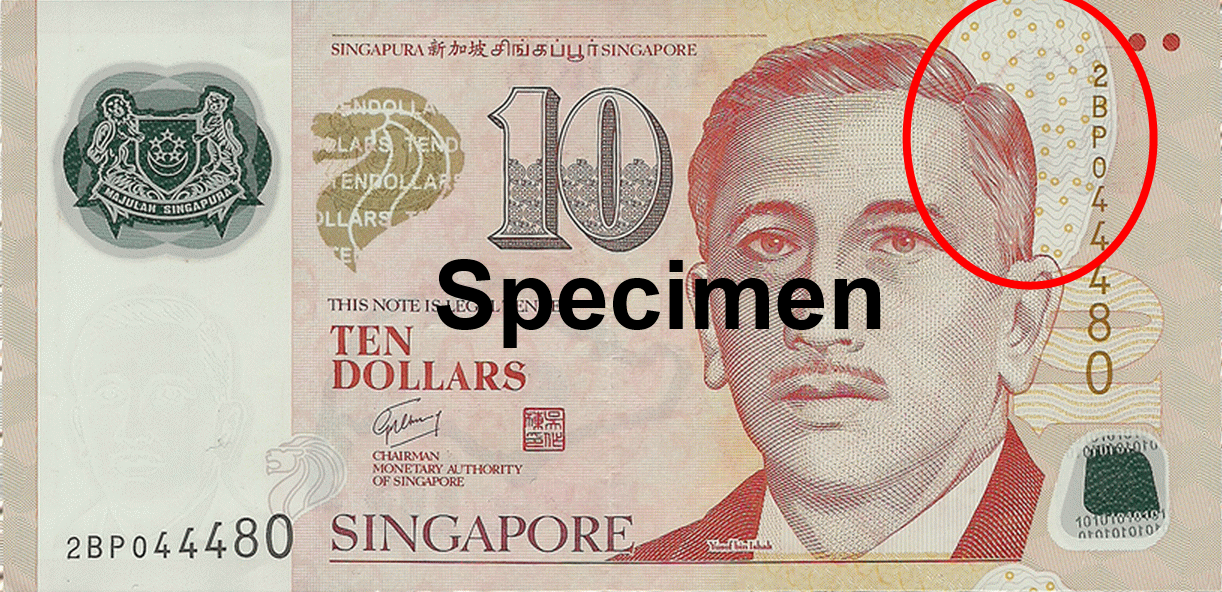 |
| Singapore $10 currency of the Portrait series notes released in September 1999. The cowrie,E. errones can be found on the circled area. |
| Value |
Specimen Note |
Type of cowries printed on the obverse |
| $2 |
 |
|
| $5 |
 |
Gold-ringed Cowrie (Monetaria annulus) |
| $10 |
 |
Wandering Cowrie (Erronea errones) |
| $50 |
 |
Cylindrical Cowrie (Erronea cylindrica) |
| $100 |
 |
Swallow Cowrie (Bistolida hirundo) |
| $1000 |
 |
Beautiful Cowrie (Luria pulchra) |
| $10,000 |
 |
Onyx Cowrie (Erronea onyx) |
| Table of the Portrait series note printed in September 1999 (Image credit: Monetary Authority of Singapore[3] ) |
Photos of the cowries printed on Singapore Dollar Notes (Photo credit: Philipp Rosenkranz) |
|
2.1 Why cowries?
Shells, were used as a form of currency in the past, as a medium to exchange for goods. Shell money can be found all over the world, on every continent and the most frequently used are the cowries, being a more charismatic and beautiful looking shell. Among them, money cowries (Monetaria moneta) were probably the most frequently adopted medium of exchange.| 'Barter. Couries used as Money' (Photo credit: Permission granted from Science & Society Picture Library) |
[3] What do I call it?
| Nomenclature Scientific (binomial) Name: Erronea errones Original Combination: Cypraea errones Common Name: Wandering Cowrie or Erroneous Cowrie Etymology (origins of name): The common name comes from the latin translation of the word 'erroneus' which refers to a wanderer |
[4] How do I know a shell belongs to E. errones?
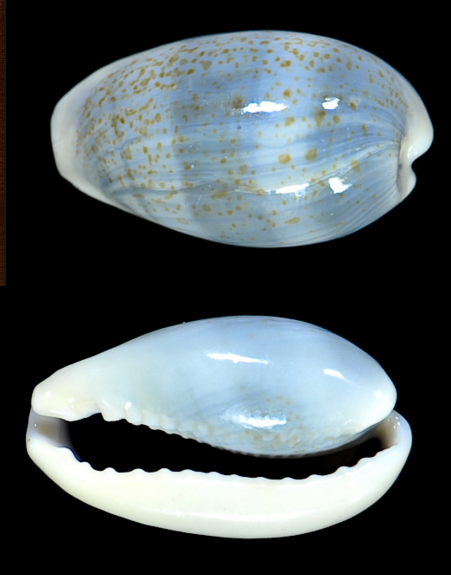 |
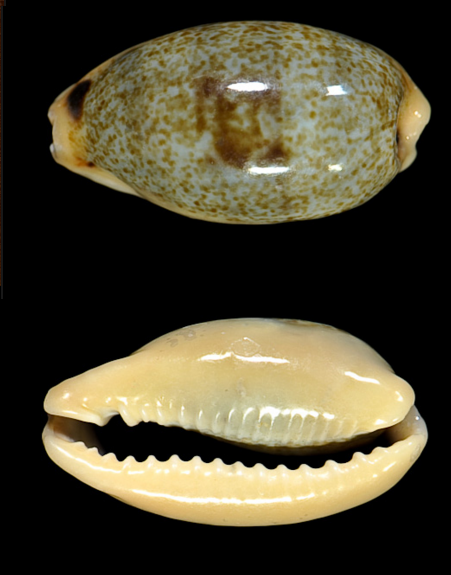 |
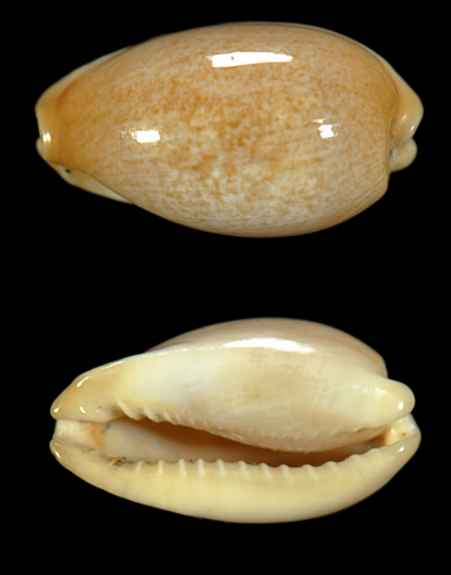 |
| From left to right :Erronea errones azurea, Erronea errones bimaculata, Erronea errones errones (Photos credit: Philipp Rosenkranz) |
||
Lets have a look at all the subspecies and variations of our wandering cowrie![5]
| Erronea |
errones errones |
errones azurea |
errones "bimaculata" |
errones "coxi" |
errones "caerulescens" |
| Status |
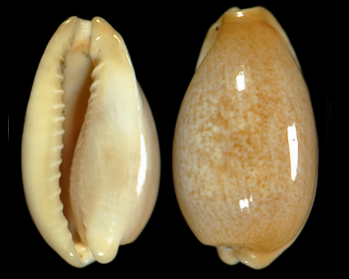 Subspecies |
 Subspecies |
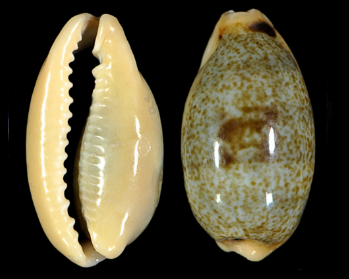 Variant |
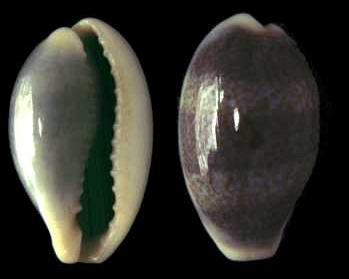 Variant |
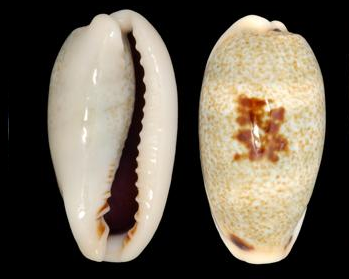 Variant |
| Shape |
Cylindrical |
Oval |
Elongate oval |
Oval pyriform (Pear-shaped) |
Oval |
| Dorsal color; blotch |
Pale green-blue/ brown; indistinct |
Blue,banded; no dorsal pattern |
Dark-green; distinct when present |
Dark bluish; distinct when present |
Light brownish; distinct when present |
| Columellar teeth |
Strong |
Rather fine |
Strong, slightly outstanding |
Rather fine |
Rather fine |
| Base color; Aperture |
Pale cream; Narrow to wide |
Plain white; Rather wide |
Tanned orange; Rather narrow |
White to tanned; Rather wide |
Thin translucent; Narrow to wide |
If you are not sure of which are the parts of shell we are referring to above, click here to jump to morphology section!
Varieties in E. errones are mostly obscured by ecological influenced modification (e.g what are the available shell-making minerals, their diet). This is why they are rarely elevated to species or subspecies level, and remain as a variant.
So how exactly do we describe this species with such a variety of visual differences?
4.1 Going back to the original description by Linnaeus 1758...
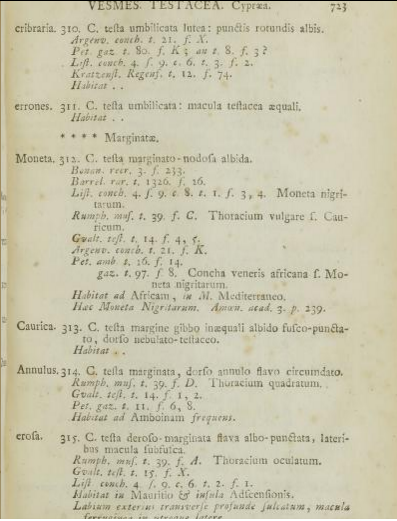 |
| Original description of E. errones under Cypraea errones by Linnaeus (1758) in Systema naturae[6] . |
"C. tefta umbilicata: macula teftacea aequali"
According to Dodge[7] (1955) it only tells us that the shell is umbilicate (having a central depression) and showed a spot, assumed to be the one on the dorsum. He also mentions that the phrase "macula testacea aequali" cannot be comprehensively translated. Individually, the word "testacea'"is often utilized by Linnaeus to refer to "shell-colored". Not only is this vague, but it is also incorrect as we can see from the specimens above that coloration ranges greatly. "Aequali" word can be interpreted as "symmetrical" likely referring to the dorsal maculation, which is also inconsistent across the complex organism associated with this species name.
The only useful information perhaps is given in the subdescription:
"Differt a C. stolida macula una, nec pluribus."
Which basically means that the color pattern of the E. errones shell varies intraspecifically.
There is no locality or geographical information included in this diagnosis as well.
4.2 A clue through taxonavigation?
This species of cowrie was derived from the following classification :| Kingdom |
Animalia |
|||||||
|---|---|---|---|---|---|---|---|---|
| Phylum |
Mollusca |
|||||||
| Class |
Gastropoda |
|||||||
| Order |
Littorinimorpha |
|||||||
| Superfamily |
Cypraeoidea |
|||||||
| Family |
Cypraeidae |
|||||||
| Genus |
Erronea |
|||||||
| Species |
errones |
4.3 Morphology of E. errones
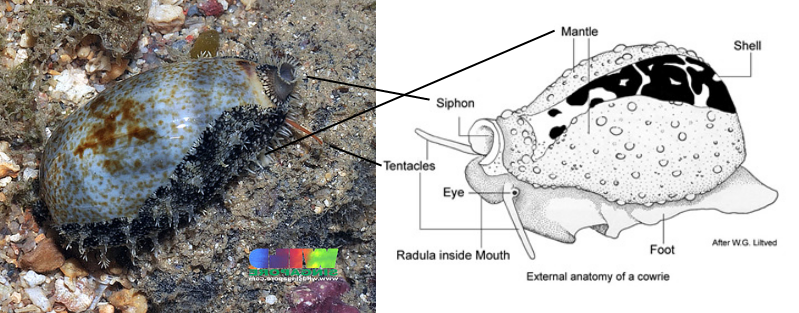 |
| Diagrammatic comparison of a cowrie morphology (Photo credit: Smithsonian National Musem of Natural History[8] , Ria Tan, Edited by Zong Rui Tan) |
 |
| Shell morphology (Photo credit: Zong Rui Tan) |
Extending from the mantle are the tentacles, at the base of which the eyes can be found, along with the siphon that is modified for breathing and sensing chemical cues. These are important biological features for the cowries to detect changes in the environment.
  |
| E. errones with mantle covering the shell (Photo credits: Ria Tan) |
Erronea errones belongs to the large taxonomic subclass prosobranchia which translate literally to 'gills in front' [of the heart]. In addition, the mantle cavity and anus is also situated in front as well. This subclass was dismissed from the actual taxonomy when it was found to contain lineages of multiple descent (polyphyly), and became more of an anatomically descriptive term for a taxa.
4.4 Could this be...
The Ovum Cowrie (Erronea ovum) is often mistaken for our E. errones. Let us put what we have learnt about their morphology to the test and try telling them apart!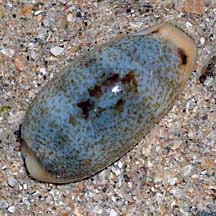 Wandering cowrie Erronea errones |
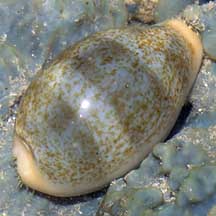 Ovum Cowrie Erronea ovum |
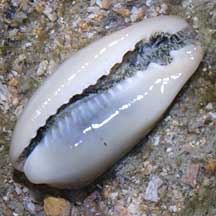 Cylindrical shell |
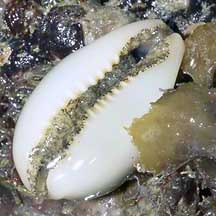 Pear-shaped shell |
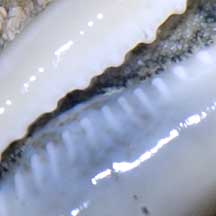 Does not have coloured teeth |
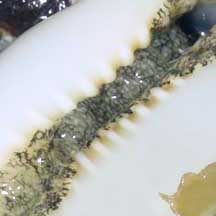 Teeth that have a tinge of orange or yellow |
| Differentiating Ovum and Wandering cowrie (Photo credits: Ria Tan) |
|
[5] Where can we find this awesome looking shell?
Cowries typically can live in shallow to deep water habitats. In Singapore, they can be commonly found in shallower waters of the coral rubles, coral reefs, near sponges or even on open rocky shores. Adult E. errones are benthic creatures, thus they can only be found crawling on the shores with corals or rocks. Have a look at the few places where the wandering cowrie have been spotted on Singapore's shores!The next map will show the areas which each subspecies and variant of E. errones have been found globally.[9] Being a tropical or subtropical dweller of the cowrie family, E. errones can be found distributed across the East Indian Ocean and West Pacific Ocean. As their shell morphology can vary due to environment, many of the variants can be found clustered in certain parts of the world.
| Environmental ranges[10] |
|
|---|---|
| Depth range (m) |
0.5 - 70 |
| Temperature range (°C) |
23.011 - 28.488 |
| Salinity (PPS) |
33.691 -34.975 |
| Oxygen (ml/l) |
4.336-4.754 |
[6] What do they feed on?
Known as the grazers of the sea, wandering cowries feed by scraping algae off substrates. Its herbivorous diet is pretty befitting of its moniker, as it practically feeds like a sheep.Like many other animals, the diet of gastropods is dependent on their denture, known as radula. For E. errones, it possess a typical taenioglossan radula (below) that consist of seven teeth on each row: one middle tooth, flanked on each side by one lateral and two marginal teeth, giving the 2+1+R+1+2 formula.
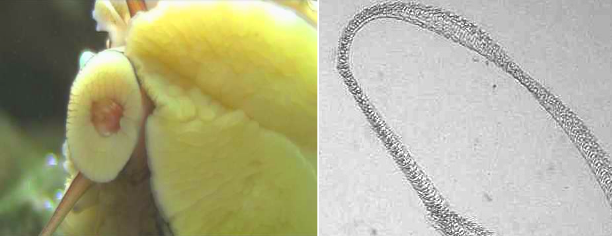 |
 |
| Left to right: E. errones feeding; Radula of E. errones observed under a microscope (Photo credit: Zong Rui Tan) |
SEM image of the Taenioglossan radula of E. errones (Photo credit: Florida Museum of Natural History)[11] |
[7] What about mating and reproduction?
As a member of the previously used order Neotaenioglossa (subsequently placed into Littorinimorpha), the cowrie is likely have separate sexes - male and female (gonochoric). They are also broadcast spawners, releasing sperms and eggs into the open waters.Cowries, including E. errones pictured below, are brood-protecting animals[12] . Thus cowries can often be found perching over their eggs on corals, boulders or rocks where they have laid their eggs. Their foot will be fully extended to cover the egg masses which are horny, glossy and pale yellow in color[13] .
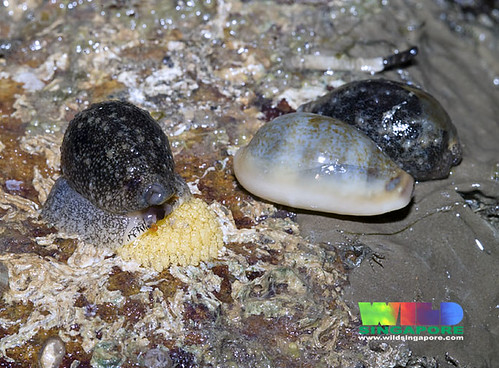 |
| Erronea Errones resting on a boulder, the left most one perching on its eggs. (Photo credit: Ria Tan) |
So next time, do the mother-cowrie a favour, if you ever see a cowrie perched on a boulder, do NOT remove it as you might separate the mother from her eggs!
Once hatched, the juvenile snail would be in the form of a trochophore larvae and rapidly develop into a veliger larva. It will already possess a shell with reticulate markings and pale brownish in color. A typical character of a veliger larvae is the velum, which is bi-lobed and colorless, with long cilia that helps to gather food towards its mouth.
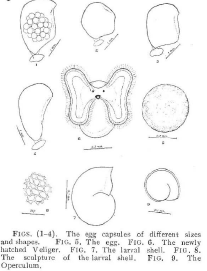 |
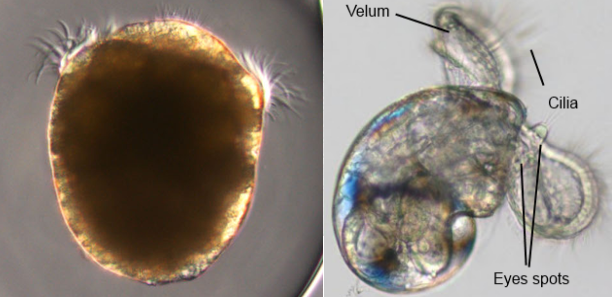 |
| Drawings of the egg capsules and veliger larvae of E. errones (Photo credit: Natarajan ) |
Left to right: Photo of a trochophore larvae (first stage); veliger larvae (second stage). Iridescence is due to usage of polarised light. (Photo credit: Mary Janna Grove[14] , edited by: Zong Rui Tan) |
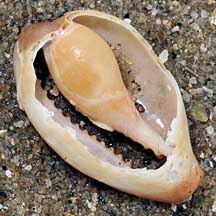 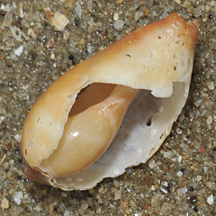 |
| Broken shell of a cowrie, exposing the "dwarf shell" in the interior (Photo credit: Ria Tan) |
[8] How does the wandering cowrie defend itself?
As mentioned earlier, the mantle of the cowrie keeps this shells smooth, making it hard for the predators to have a good grip over it. Moreover, the snail will protect itself by retracting back into its hard shells, which is difficult to fish the flesh out of. In addition, the mantle has many tiny protrusions and dull colouring, allowing it to blend into its surroundings and camouflage the shell. |
| Blending into the surrounding with the mantle extended. (Photo credit: Ria Tan) |
E. errones.
These includes some of the crustaceans (e.g crabs, prawns) that are able to break the shells and reach in for the flesh.
With the whole shell intact, they can also be preyed on by the cone snails, which inject venom into the cowrie flesh before reaching in to feed and ingest the soft tissue of the cowrie.
| From left to right: Cone snail (Conus marmoreus)detecting its prey(Mole cowrie) with its siphon; Once deem edible it will extend venomous harpoon (circled) to stun the prey. (Photo credit: Jeanette Johnson[15] , edited by Zong Rui Tan) |
[9] It's so pretty! Can I bring one home?
That is highly not recommended. Despite being the more common cowries on our shore and their pretty appearances, cowries are often over-collected for several reasons.Firstly for the shell collectors, they tend to collect a wide variety of shells, leading to a bustling shell trade online.
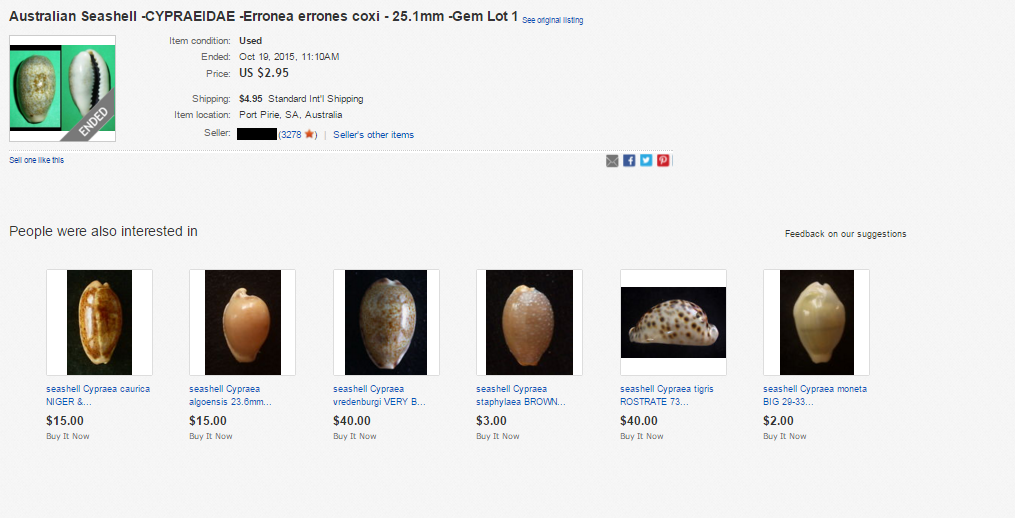 |
| Erronea errones being traded online alongside other shells. (Screen shot edited by: Zong Rui Tan) |
Similarly, they are also collected for the aquarium trade, to beautify the tank as well as to clean up the tank, by scraping off the algae on the glass.
 |
| Photo taken of a cowrie snail in an aquarium tank. (Photo credit: Wally B.) |
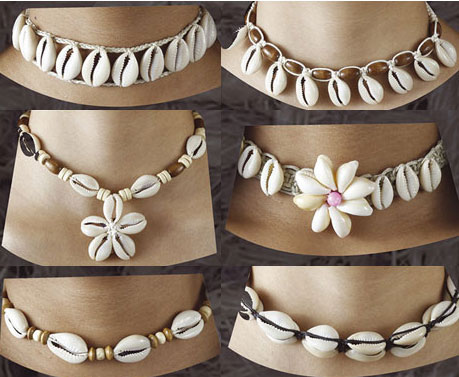 |
| Cowrie necklaces (Photo credit: batiksarong.com) |
9.1 Then aren't they at risk of being depleted?
Fortunately for us, E. errones is widely distributed and many variants are common on our shores. Therefore, it is neither listed in ICUN Red List of Threatened Species, nor in the Singapore Red Data Book of Endangered Animals.E. errones is determined as an Evolutionarily Significant Unit (ESU). ESU refers to a population that is considered distinct for conservation purposes which could be based on either phenotypic, phylogenetic or geographical differences. Even then, it is not covered by the Endangered Species Act practiced by the United States, due its healthy population.
[10] What else does this snail do?
Through a study done by Anand & Edward (2002)[16] , wandering cowries actually possess some antimicrobial activity. It was tested on 5 different members of the Erronea genus which the author still refers them under the Cypraea genus.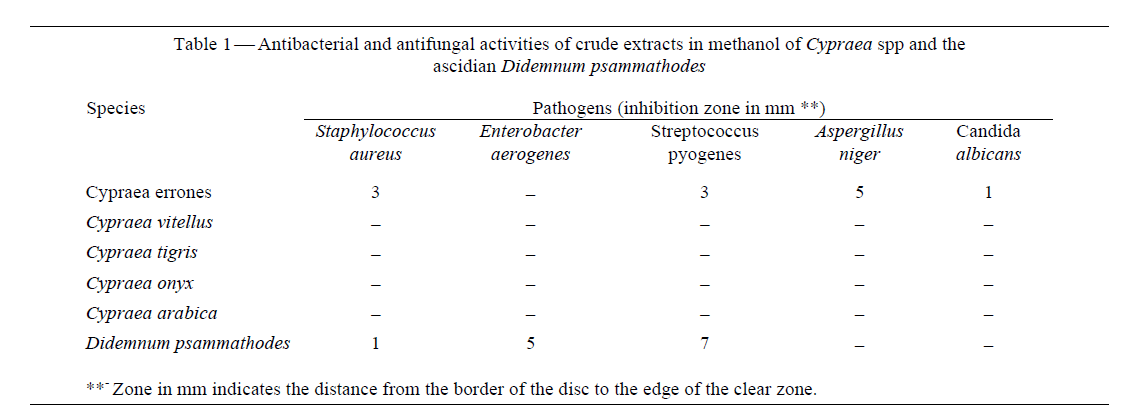 |
| Published results of study conducted by Anand & Edward (2002), showing microbial activities of Cypaea errones (E. errones) |
[11] If I don't see them on the shores, where can else can I find them?
Cowries (Cypraeidae) are one of the most well studied molluscan members. While many of the specimens may be lost due over time due to reasons like war, misplacement and such, we are fortunate that The Linnean Society of London still holds on to majority of the specimens collected and diagnosed by Linnaeus himself.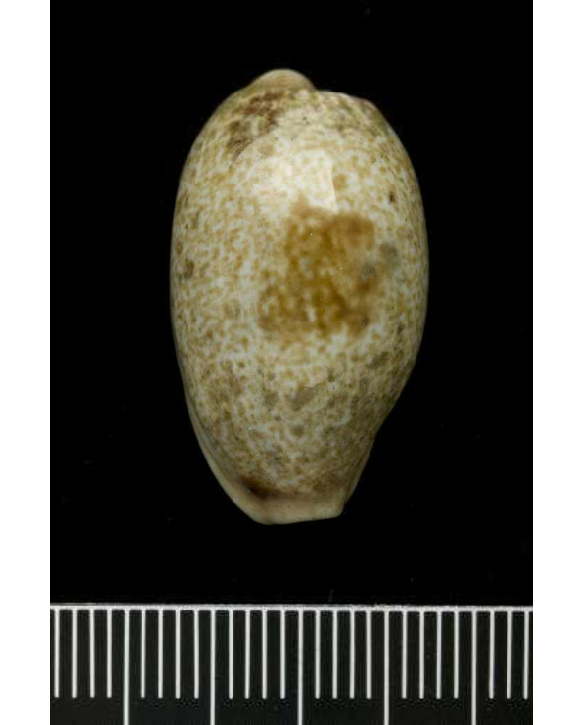 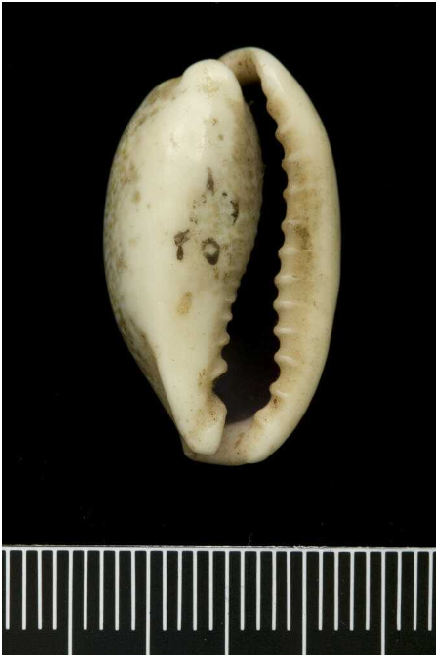 |
| Cypraea errones from the original Linnaean collection (Photo credit: The Linaean Society of London[17] ) |
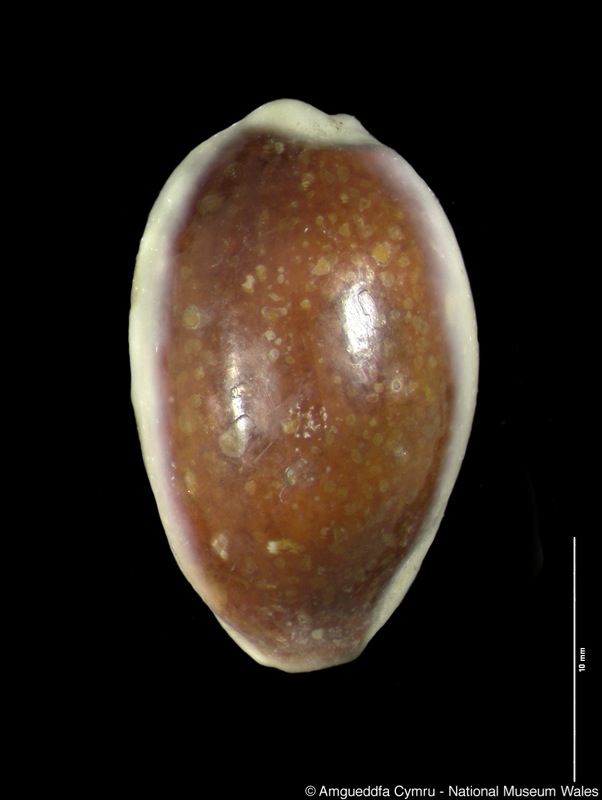 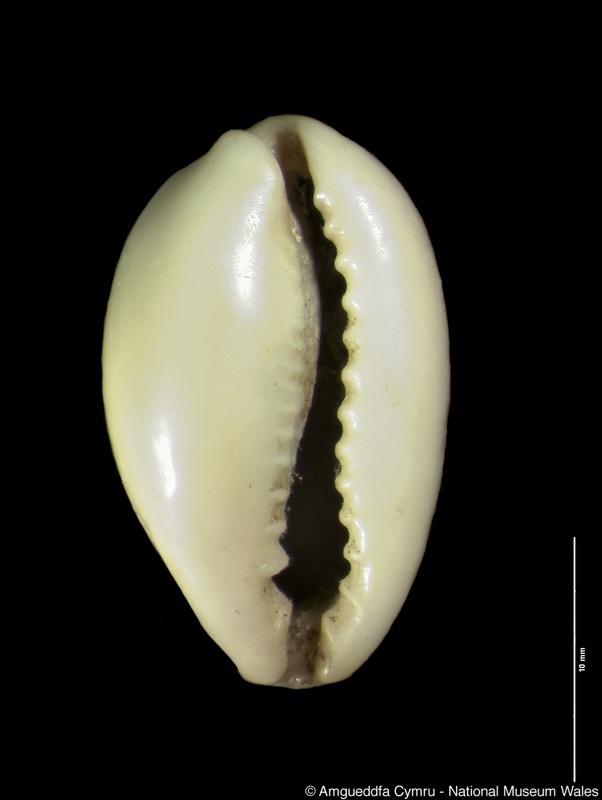 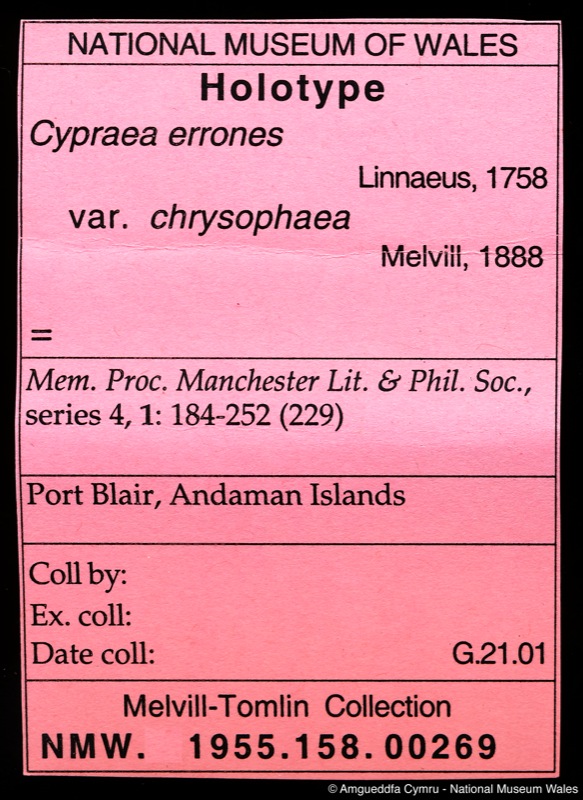 |
| Cypraea errones chrysophaea holotype specimen from National Museum of Wales, from the Mevill-Tomlin Collection (1888). (Photo credit: Museum of Wales) |
Museum Victoria
Just drop by to any nearby Natural History Museum (for Singapore: Lee Kong Chian Natural History Museum) and find our lovely shells there!
[12] Still can't tell the difference in morphology? Try molecular data!
As we progress technologically, many of the species are identified through the use of molecular data information (e.g DNA, nucleotide sequences, protein).Convergent evolution has led to many similar characteristics in separate species that make it hard to differentiate them based on visual appearances. This is apparent in many of the invertebrates that live in the same environment[18] .Molecular data grant us the ability to identify cryptic species that may appear identical morphologically to each other, and might trick the eyes of experts.
 |
| Top: CO1 sequences of the common cowries in Singapore, aligned with Muscle and viewed in Aliview. Bottom: The same set of sequence translated into amino acid sequences. E. errones, E. ovum. E.cylindrica molecular data is obtained from Singapore specimens. (Photo credit Zong Rui Tan) Eclogavena quadrimaculata appears to mismatch here due to a longer sequence used. |
You can also try it out by using sequences from National Center for Biotechnology Information (NCBI)
12.1 What is this CO1 and why is it used?
CO1 is an essential gene that codes for a protein in cellular respiration pathway in the mitochondria.Actually, any set of genes can be used in this sequencing process, however this gene is more "ideal" than the others due to the reasons below:
1)It is present in most eukaryotes (cells with membrane bound organelles).
2) It is a highly conserved gene, thus, the change in the gene sequence is slow enough to identify with same species but fast enough to differentiate separate species.
3) Cells have many copies of it which increases likelihood of extracting sufficient amount for analysis.
12.2 OK, so what can I do with all these ATCGs?
Many projects are working towards constructing a comprehensive phylogeny at appropriate levels for diversification of the taxa that are being studied.It depends a lot on the ESU mentioned previously in the conservation section which sometimes is known as operational taxonomic unit (OTU).
In the study conducted by Meyer (2004)[19] , other than being monophyly, when delineating the significant units in cowries, they have to meet at least 2 of the 3 criteria:
1) Geographical distinction or allopatry
2) Significant difference in the genetic distance such that pairwise distance comparison yields pairwise yield a bimodal distribution (2 different modes)
3) Taxonomic recognition by previous works
Most OTUs that satisfy all 3 criteria are considered as ESUs.
The results are then expressed into phylogenetic trees showing evolutionary relationships through cladogram or phylograms.
 |
| Results of phylogenetic study done by Meyer (2004), using CO1 and 16s sequences |
Now let us take a closer look at the species level.
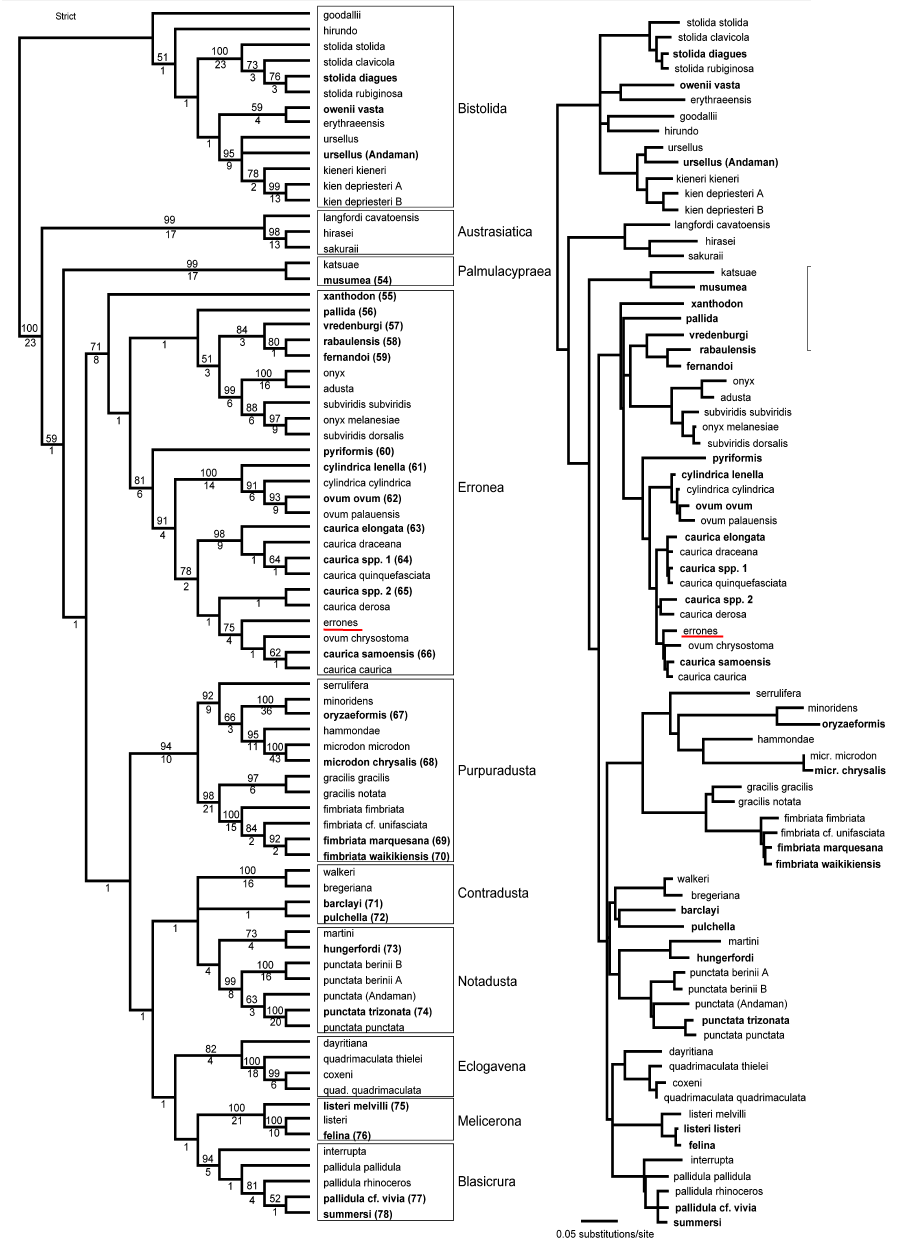 |
| Cladogram (Left) and Phylogram (Right) derived based on likelihood distance using GTR+I+G model of sequence evolution. (Meyer, 2004) |
In order for us to obtain such trees a Maximum Likelihood (ML) algorithm is adopted and requires a model of evolution (in this case: GTR + I +G). This ensures the complexity of the model so that more parameters can be covered. Results from a sufficiently complex model can then be trusted. Here Meyer used the General Time Reversible (GTR), proportion of Invariable site (I) and Gamma distribution (G) models, which are more commonly used.
Therefore with such modern technology, we are able to grasp a clearer picture of the relationship of our E. errones alongside other cowries, tracing back to the last common ancestors!
[13] Give me more!
If you are still not satisfied with what you have learnt here, go to these websites and enter the world of shells!Wikipedia
Wildsingapore
Tidechaser
Gastropods.com
Cypraea.eu
[14] References
- ^ Tan, R., 2012. Wandering cowrie (Erronea errones) on the Shores of Singapore. Wild Singapore.
http://www.wildsingapore.com/wildfacts/mollusca/gastropoda/cypraeidae/errones.htm. (Accessed November 2015). - ^
Allan, J., 1950. Australian Shells: with related animals living in the sea, in freshwater and on the land. Georgian House, Melbourne. xix 470 pp..
http://www.mas.gov.sg/Currency/Learn-About-Currency/Know-Your-Money.aspx. (Accessed November 2015)
Rosenberg, G., 2015. Erronea errones (Linnaeus, 1758). In: MolluscaBase (2015). Accessed through: World Register of Marine Species at http://www.marinespecies.org/aphia.php?p=taxdetails&id=216859. (Accessed November 2015)
Lorenz, F., & Hubert, A.,1993a. A guide to worldwide cowries. Hemmen. 106-109 pp.
Linnaeus, C., 1758. Systema Naturae, Ed. 10, Vol. 1. 824 pp. Salvii, Holmiae.
Dodge, H., 1995. "A historical review of the mollusks of Linnaeus. Part 2. The Class Cephalapoda and Genera Conus and Cypraea of the Class Gastropoda." Bull. Am. Mus. Nat. Hist 103.1 : 93 pp.
Smithsonian Museum of Natural History, 2014. Morphological Variation in the Tiger Cowrie Shell, Cypraea tigris Linnaeus, 1758
http://invertebrates.si.edu/Features/stories/cowrie.html (Accessed November 2015)
Lorenz, F., & Hubert, A.,1993b. A guide to worldwide cowries. Hemmen. 106-109 pp.
Encyclopedia of Life (EOL). Erronea errones,Detail - Ecology.
http://www.eol.org/pages/4854054/details (Accessed November 2015)
https://www.flmnh.ufl.edu/cowries/errones.htm (Accessed November 2015)
Lo Bianco S.,1899. Mitt. Zool. Stat. Nexpel. 13., 448pp
Grove M. J., 2011. Invertebrate embryology. Veliger larvae of mollusc.
http://invert-embryo.blogspot.sg/2011/05/veliger-larvae-of-molluscs.html
Johnson J., 2009. Kwajalein Underwater Conus marmoreous (Linnaeus, 1758)
http://www.underwaterkwaj.com/shell/cone/Conus-marmoreus.htm (Accessed November 2015)
Anand, T. P., & Edward, J. K. P., 2002. Antimicrobial activity in the tissue extracts of five species of cowries Cypraea spp.(Mollusca: Gastropoda) and an ascidian Didemnum psammathodes (Tunicata: Didemnidae). Indian journal of marine sciences, 31(3), 239-242
The Linnean Society of London. Cypraea errones (Linnaeus, 1758) .Online Collection. http://linnean-online.org/16986/ (Accessed November 2015)
Moore, J., & Willmer, P.,1997. Convergent evolution in invertebrates.Biological Reviews of the Cambridge Philosophical Society, 72(01), 1-60.
Meyer, C. P., 2004. Toward comprehensiveness: Increased molecular sampling within Cypraeidae and its phylogenetic implications. MALACOLOGIA-PHILADELPHIA-, 46(1), 127-156.
